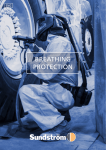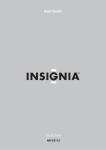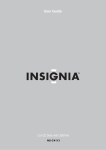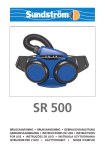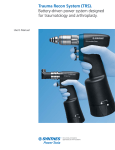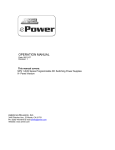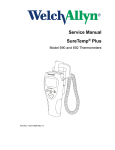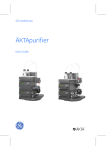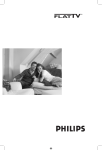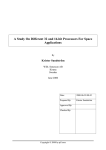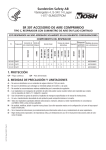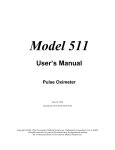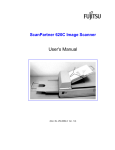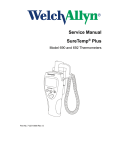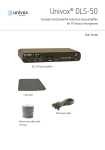Download BREATHING PROTECTION
Transcript
OR ENT! O W SECURE ND NM SAFE A Breathing PROTECTION KING ENV Reliable protection since 1926 IR The unhealthy air of the mines led to the first RESPIRATORS Sundström Safety AB was founded by Ivan Sundström in 1926. Mining engineer Ivan Sundström observed that the eyes and lungs of the miners had to be protected and founded Sundström Safety AB back in 1926 for manufacturing of respirators. The company and its products were developed further by his son Per, who also studied art at the Technical Academy (now the College of Art). During his studies, he learnt how to analyse the human anatomy. His understanding of face shapes laid the foundations for developing the design and properties of the respirators. Good respiratory protection had to be simple and comfortable to use. In 1972, Sundström presented the first modern half mask respirator made of rubber in an anatomical design. The first silicone mask was launched in 1989. Our aim is to protect people from airborne hazards. It was this concern that prompted Ivan Sundström to begin manufacturing protective respirators. We then carried this task over into the 21st century. That is why we are not content merely to conform to the standard requirements. Our ambitions go considerably further. We aim to assure optimal protection. Although we are very satisfied with our current products, we continue to make major investments in product development. We now offer a complete system of masks, filters and accessories for all applications on the market and are continuously working to create products which are as efficient as possible. The founder’s son Per Sundström launched the first rubber half mask respirator in 1972. When our grandfather Ivan founded his company, he could never have imagined today’s export-oriented business. But he would certainly have hoped that the company would continue to exist and remain within the family. And that’s how it has been and how we aim to keep it in future. Per Sundström died in December 2004, and the third generation of the family now continues to run the company in the same spirit. Production and product development take place in Lagan in the province of Småland and the main office is located in Lidingö outside Stockholm. The company celebrated its 85th anniversary in 2011. Sundström Safety AB has been certified to ISO 9001 since 1993. 2 Selecting respiratory protection When all other measures have been taken to reduce dangerous levels of exposure, respiratory protection is the last but important step to prevent harmful air contaminants from entering the body through the airways. 4 Things to consider • Identification: which hazardous gases, vapours, dust, smoke or aerosols do we need to protect ourselves from? Make workplace measurements and monitor the concentrations of the hazardous substances. • Risk assessment: is sufficient oxygen level present during the entire period of exposure? What are the effects on health of the substances present? Are there any occupational exposure limits for these substances? Are there any other risks, such as splashing, sparks or explosive mixtures? • Selection of breathing protection: half mask, full-face mask, powered or air fed respirators. • Training: fitting, function checks, donning, storage and maintenance. Routines for cleaning and replacing filters and wearing parts. The employer is responsible for the selection, maintenance and provision of breathing protection equipment and its use in the workplace. The user is in his turn responsible for using it according to the employer’s routines. A programme designed to protect employees from exposure to air contaminants is described in the EN 529:2005 guidelines: recommendations for the selection, use, care and maintenance of respiratory protection equipment. Two types of breathing protection Filter protection, where the surrounding air passes through filters that remove contaminants. This type is used where sufficient oxygen level is present and known contaminants can be captured in the filter. The contaminants must have clear warning properties in the form of odours or taste in concentrations below the occupational exposure limits. Filters must not be used where the contaminant concentrations are Immediately Dangerous to Life and Health. Examples of filter protection are half and full face masks with replaceable filters as well as powered-assisted filter protection for half and full masks or hoods, visors and helmets. For contaminants in gas form, appropriate gas filters are used with active carbon that adsorbs the gas. As the filter becomes saturated the gradual breakthrough starts, therefor it is important to set up a filter replacement policy. Particles such as dust, smoke and mist are captured in particle filters. As the degree of clogging rises, breathing resistance increases and the filter must be replaced if it is damaged or breathing becomes difficult. Combination filters are used in the presence of both particles and gas. Breathing apparatus supplies the user with air from an independent source, via cylinders with compressed air or breathable air from a compressor. Continuous flow air line equipment with hoses is used in half and full face masks, hoods, helmets and visors. Compressed-air fed breathing protection may be used in all environments suitable for filters and in which a higher level of protection is required. Some substances can not be adsorbed in filters, and in such cases compressed-air fed breathing protection is the only alternative. The inhaled air must conform to EN 12021 and as an example not exceed the odour threshold for oil (0.5 mg/m3). 3 Selecting respiratory protection on the basis of level of contaminant – protection factor All types of breathing protection have a specific protection factor that describes how efficiently they reduce the level of the contaminant in the airways, i.e. inside the face piece. The Assigned Protection Factor (APF) is based on measurements inside and outside the protective device, conducted on workers in real work environments. The Nominal Protection factor (NPF) is based on laboratory measurements in conjunction with approval of the protection equipment to the EN standard. Calculation of the protection needed at the workplace should be based on the Assigned Protection Factor (APF). Check national requirements for assigned protection factors EN 529. The following calculations can be made on the basis of the degree of pollution, ideally determined by work environment measurements, and the occupational exposure limit of the substance involved: N.B: Filter protection must never be used in concentrations Immediately Dangerous to Life and Health (IDLH). Select appropriate breathing protection whose protection factor exceeds the required protection factor. Important formulas Required protection factor = contaminant concentration /OEL Max. user concentration= OEL x APF In the event of exposure to carcinogenic, sensitizing and similar substances, it is important to select equipment with a maximum protection factor so that the contaminant concentrations within the mask are minimized. Various types of filter protection and their nominal protection factors are shown below. Concentration in the respirator = contaminant concentration /APF OEL= Occupational Exposure limit APF= Assigned protection factor Powered hood/visor/helmet Masks TH1..........10 Filtering facepiece FFP...............4 TH2..........50 Compressed air line EN 14594 Filtering facepiece FFP2............12 TH3..........500 times A designates light duty, i.e. spiral hose SR 360 Sundström half masks.....50 times B designates heavy duty, i.e. tubes SR 358 and SR 359 1A/1B.......10 Full face mask SR 200..........2000 times 2A/2B.......50 3A/3B.......200 times Powered w. full face mask TM3 Sundström..........2000 times 4A/4B........2000 times * For Assigned Protection Factors check National regulations. 4 OR ENT! O NM SAFE A W SECURE ND KING ENV IR Selecting breathing protection on the basis of work duration and workload For short term jobs with a low workload, a negative pressure mask can be used, i.e. half and full face masks with replaceable filters. To avoid harmful leakage into the mask, the fit to the face is important, as inhaling produces a negative pressure in the mask. High inhalation resistance due to large filter combinations contributes to further negative pressure as well as an increased breathing effort. Long term work with high workloads often requires powered-assisted filter protection. A batterydriven fan sucks the air through the filter and blows it into the face piece, which may be a loose-fitting visor, helmet or hood, or a tight fitting half or full face mask. The air flow of the equipment is important to maintain a positive pressure in the face piece, even during deep inhalation, especially with the use of loose fitting visors, helmets or hoods. High workloads and contaminants with poor warning properties are examples of situations in which compressed air line equipment is appropiate. The compressed air is supplied from a compressor via an air line filter unit and hose to a belt-mounted regulating valve, to the half or full face mask or helmet, visor or hood. Two different fit tests can be used to assure a good fit for half and full face masks. Qualitative (subjective) test: The user dons the protective mask as described in the user manual and is exposed to a substance with a smell, such as isoamyl acetate, or with a taste, such as Saccharin or Bitrex. If the user cannot smell or taste anything, then the respirator has a good fit. Quantitative (objective) fit test: The numbers of particles in the ambient air and inside the mask are measured to obtain a ratio describing how well the breathing protection fits. During this test, several exercises are carried out that simulate various situations which may occur during a normal work shift. The qualitative test depends on the user’s sense of smell and/or taste and is considered to be less suitable than a quantitative test for measuring how well the mask fits. Sundström Safety offers qualified training by our specialists in fitting, function checks, donning, storage and maintenance – in order to ensure a high level of protection for many years. 5 Half and full face masks Sundström Safety manufactures half and full face masks designed for the toughest applications. The masks are known for their excellent fit, high protection level and breathing comfort. • All masks in Sundström Safety’s programme use the same range of filters and can be combined efficiently and cost-effectively to suit each situation. • If compressed air is needed, for instance in the case of contaminants with poor warning properties, compressed air attachment SR 307 can be connected to all masks. See Page 17. Half mask SR 900 in three sizes • Made of soft thermoplastic for optimal comfort and fit. • Together with particle filter SR 510 P3 R, this is a safer, environmentally friendly and very cost-effective solution compared with disposable/paper masks. • A direct air flow into the mask and two exhalation valves ensure a very low breathing resistance. • Produced in three sizes to assure a good fit for most face shapes. SR 900 Small – Art no H01-3012 SR 900 Medium – Art no H01-3112 SR 900 Large – Art no H01-3212 Half mask SR 100 in three sizes • One of the world’s most comfortable and reliable half masks. • Made from silicone throughout, with wide and soft application surfaces for an optimal fit. • Direct air flow into the mask and two exhalation valves ensure a very low breathing resistance. For professional use! SR 100 S/M – Art no H01-2112 SR 100 M/L – Art no H01-2012 SR 100 L/XL – Art no H01-2812 • Two exhalation valves minimize and reduce the formation of moisture in the mask. • Harness and mask attachment distribute the pressure equally against the face. • A long service life with few spares simplifies care and maintenance. Premium Pack Premium Plus Pack Contents 1 SR 100 half mask in silicone 1 SR 510 P3 R particle filter 1 SR 217 A1 gas filter, protects against most solvents 5 pre-filters 1 pre-filter holder 1 test disc for fit check 1 cleaning wipe 1 set of instructions with maintenance information Contents 1 SR 100 half mask in silicon 1 SR 510 P3 R particle filter 1 SR 297 ABEK1 gas filter, protects against a wide range of gases 5 pre-filters 1 pre-filter holder 1 test disc for fit check 1 cleaning wipe 1 set of instructions with maintenance information • Brush painting, gas filter only • Spray painting, combined gas and particle filters • High-pressure washing with degreasing, combined gas and particle filters • Pesticides and spraying, combined gas and particle filters • Adhesives and lacquer with brush, gas filter only • Agriculture • Municipal sewage and treatment plants • Waste and refuse plants • Operations with many different contaminants, where you want to be sure not to choose the wrong filter 6 Important spares and practical accessories Harness SR 363 (single) for SR 100 Art no R01-2001 Harness SR 362 (separated) for SR 100 Art no R01-2002 Harness (single) for SR 900 Art no R01-3001 Harness (separated) for SR 900 Art no R01-3002 Pre-filter holders Art no R01-0605 Membrane set – out x 2 / in x 1 / valve cap x 2 Art no R01-2004 Service set SR 900 – harness/pre-filter holder/membrane set Art no R01-3002 Head harness SR 363, single strap, (SR 100) Art no R01-2001 Storage box SR 230 Art no H09-3012 Protective hood SR 64 made of Tyvek© material Art no H09-0301 Protective hood SR 345, PVC. Art no H09-0112 Art no H09-1012 OR ENT! O W SECURE ND NM SAFE A Storage bag SR 339 KING ENV IR Spares and practical accessories. For complete information, go to srsafety.com 7 OR ENT! O NM SAFE A W SECURE ND KING ENV IR If eye protection is required and/or at higher concentrations SR 200 Full face mask • Made of silicone with a unique airflow that minimises inhalation and exhalation resistance. • Spherical visor with a very wide field of vision. • Integrated internal mask for simple cleaning. • Comfortable and easily adjustable textile harness. SR 200 with PC visor – Art no H01-1212 SR 200 with glass visor – Art no H01-1312 Important spares and practical accessories PC visor SR 366 (polycarbonate) Art no R01-1201 Peel-off visor SR 343 for polycarbonate visor Art no T01-1204 Glass visor SR 365 (laminated glass) Art no T01-1203 Spectacle frame SR 341 Peel-off visor SR 353 for glass visor Art no T01-1205 Art no T01-1201 Harness - textile Art no R01-1203 Welding cassette SR 84 Harness SR 340 - rubber Art no T01-1215 Art no T01-1212 Filter adapter SR 280-3 Art no H09-0212 Gasket for filter connection Art no R01-1205 Pre-filter holder Art no R01-0605 Membrane set – out x 2 / in x 3 / drop x 2 / valve cap x 2 Art no R01-1204 Test adapter SR 370 for fit test Art no T01-1206 Protective hood SR 345 in PVC Art no H09-1012 Storage box SR 344 Art no T01-1214 Protective hood SR 64, Storage box SR 344 Tyvek© Art no T01-1214 Art no H09-0301 8 Filters Particle filters for half and full face masks are divided into three classes depending on how effectively they can separate dust. Colour code - white. ”R” after the class means that the particle filter can be reused. Protection classes with respect to efficiency (EN 143) (NaCl and paraffin oil) P1 R/NR solid and wet particles 1 80 % P2 R/NR solid and wet particles 2 94 % P3 R/NR solid and wet particles 3 99,95 % ”NR” after the class means that the particle filter must not be used for more than one shift. Filter typeProtects against COLOUR CODE A B Organic gases/vapours with a boiling point above 65ºC, e.g. solvent naphtha, toluene, styrene and xylene Inorganic gases/vapours such as chlorine, hydrogen cyanide and hydrogen sulphide Acidic gases/vapours such as sulphur dioxide and formic acid Organic gases and vapours with a boiling point below 65ºC, such as acetone, methanol and dichloromethane E K AX A highly efficient filter such as the SR 510 P3 R offers protection against all types of particles. A higher class also covers the lower ones, i.e. P3 covers both P1 and P2. The filters are replaced when the particle filter leads to increased breathing resistance. Particle filters offer protection only against particles. Gas filters for half and full masks are divided into three classes on the basis of their capacity Ammonia and certain amines and test concentration. Hg-P3 Filter class (EN 14387) Tested in concentrations 1 0,1 percent by volume=1000ppm Mercury Gas filters afford protection only against gases. 2 0,5 percent by volume=5000ppm 3 1,0 percent by volume=10000ppm ppm=part per milion Combination filters Combination filters are used when gases/vapours occur simultaneously with particles, e.g. in high-pressure cleaning, spray painting, heating substances or gas condensation. Select an appropriate gas filter and combine it with a particle filter by simply pressing them together or use filters with a fixed gas and particle filter in one. Gas- and particle filters SR 217 A1 – Art no H02-2512 SR 218 A2 – Art no H02-2012 SR 217 A1 and SR 218 A2 offer protection against organic compounds with a boiling point above 65ºC. SR 297 ABEK1 – Art no H02-5312 SR 510 P3 – Art no H02-1312 SR 297 ABEK1 offers protection against the same types of contaminant as gas filter SR 315 as well as against ammonia. SR 510 P3 R is a mechanical particle filter with extremely low breathing resistance. SR 510 offers protection against all types of particles (dust, smoke, mist, spray, asbestos), as well as bacteria, viruses and radioactive fallout. Filtering efficiency more than 99.997%. SR 510 is used for all protective filters in Sundström Safety’s programme. SR 316 K1 – Art no H02-4212 SR 295 K2 – Art no H02-4312 SR 298 AX – Art no H02-2412 SR 316 K1 and SR 295 K offer protection against ammonia and certain amines. SR 298 AX offers protection against organic compounds with a boiling point below or equal to 65ºC. If gas/vapour and particles occur simultaneously, a particle filter is combined with a suitable gas filter. SR 221 Pre filter – Art no H02-0312 SR 315 ABE1 – Art no H02-3212 SR 294 ABE2 – Art no H02-3312 SR 299-2 ABEK1 Hg P3 Combined filter – Art no H02-6512 SR 315 ABE1 and SR 294 ABE2 offer protection against organic compounds with a boiling point above 65º, inorganic compounds and acidic gases/vapours. SR 299-2 ABEK1 Hg P3 R offers protection against organic compounds with a boiling point above 65º, inorganic compounds and acidic gases/vapours, ammonia, mercury vapour as well as against all types of particles. The maximum time of use for protection against mercury vapour is 50 hours. SR 221 must be used together with particle, gas and combination filters at all times. The pre-filter protects the main filter against premature clogging by larger particles. The pre-filter holder fixes the filter in place and protects it against handling damage. Spares and practical accessories. For complete information, go to srsafety.com 9 For work that is heavy, hot or of long duration Powered-assisted filter protection Sundström Safety’s powered-assisted filter protection equipment is designed to give the user the maximum level of protection, comfort, simplicity and cost-effectiveness. Fan units SR 500 and SR 700 are characterized by: • A high air flow, 175 or 240 l/min., which assures positive pressure in the face piece even during heavy workload and maintains high level of protection. • The high air flow of both fans, SR 500 and SR 700, assures the highest protection class TH3 or TM3 for all face pieces. • Automatic flow control monitors and maintains the set air flow rate, i.e. no calibration. • Alarm functions for clogged particle filters and low battery capacity. • Display with clear symbols for key data, e.g. selected air flow and type of alarm. • Detachable lithium-ion batteries for fast charging and long service life. • Wide range of face pieces such as hoods, helmets and visors, all in TH3. They can also be connected to the SR 200 full mask, TM3. • The electronics and fan case are very well encapsulated (IP67), thus facilitating any vigorous cleaning that may be required. • All fans are supplied with a battery, charger, belt, flow meter, pre-filter holder, pre-filter and particle filter. Select a fan For particles only The SR 700 is a compact lightweight fan designed especially to provide protection against harmful particles where optimal protection properties are required. It is equipped with two particle filters, SR 510 P3 R, or threaded filter SR 710 P3 R, as well as pre-filter SR 221. • With acoustic and optical alarms. • Battery SR 701, 14.8V, 2.2 Ah, lithium-ion with a charging time of approx. 2 hours. • Approx. 8 hours operating time at a flow rate of 175 l/min., and approx. 5 hours at 225 l/min. SR 700 – Art no H06-7010 Both particles and gas The SR 500 is a fan unit designed to give protection against harmful particles as well as gases and vapours. It is equipped with two particle filters SR 510 P3 R or a threaded filter SR 710 P3 R and two pre-filters SR 221 for protection against particles. For protection against gas exposure: two gas filters SR 518 A2, or two gas filters SR 515 ABE1, or two SR 597 A1B2E2K1 and particle filters SR 510 P3 R. NB: Gas filters must be used in combination with particle filters at all times. • Optical, acoustic and vibration alarms. • Standard battery SR 501, 14.8 V, 2.2 Ah, lithium-ion with 30 min. charging time to reach 80% and 1.5 hours to reach 100%. • Heavy duty battery SR 502, 14.8 V, 3.6 Ah, lithium-ion with 45 min. charging time to reach 80% and 2 hours to reach 100%. • The display indicates the battery capacity when the fan starts. • Operating time up to 13 hours depending on selection of filter, flow rate and battery type. SR 500 – Art no H06-0112 10 Charging station SR 506, unassembled, can be fitted with 1-5 chargers Art no T06-0108 Pre-filter holder SR 509 for SR 500 Art no R06-0106 Splash cover SR 514 for SR 500 and SR 700 Art no T06-0114 Important spares and practical accessories Textile belt for SR 500 and SR 700 Art no R06-0101 Leather belt SR 503 for SR 500 and SR 700 Art no T06-0103 Rubber belt SR 504 for SR 500 and SR 700 Art no T06-0104 Standard battery for SR 500 Art no R06-0102 Heavy duty battery SR 502 for SR 500 Art no T06-0101 Standard battery SR 700 Art no R06-0708 Gasket for fans SR 500 and SR 700 Art no R06-0107 Particle filter adapter for SR 500 Art no R06-0105 Particle filter adapter for SR 700 Art no R06-0701 Pre-filter holder SR 509 for decontamination work for SR 500 Art no T06-0105 Pre-filter holder for SR 700 Art no R01-0605 Storage bag SR 505 for SR 500 and SR 700 Art no T06-0114 Harness SR 552 for SR 500 and SR 700 Art no T06-0116 Filters for POWERED DEVICES SR 510 particle filter P3 R – Art no H02-1312 is a mechanical particle filter of class P3 R with an extremely high efficiency >99.997% and an active area of 13 dm2. The filter can be used together with an adapter in the case of simple particle contaminants or in combination with a suitable gas filter. SR 510 is used for all filter protection equipment in Sundström Safety’s programme. SR 518 gas filter A2 – Art no H02-7012 is a filter for protection against organic compounds with a boiling point above +65°C, i.e. most solvents. Class 2 means high capacity and thus a long operating time. Gas filters for fan SR 500 must be used in combination with particle filter SR 510 P3 R at all times. SR 597 gas filter A1BE2K1 – Art no H02-7212 offers protection against organic compounds with a boiling point above +65°C, inorganic and acidic gases as well as ammonia and certain amines. Gas filters for the SR 500 fan should be used in combination with particle filter SR 510 P3 R at all times. SR 710 particle filter P3 R – Art no H02-1512 is a mechanical particle filter of class P3 R with an extremely high efficiency (> 99.997%) and an active area of 13 dm2. The filter offers protection against all types of particles, both solids and liquids. SR 710 cannot be combined with gas filters. SR 515 gas filter ABE1 – Art no H02-7112 is designed to assure protection against organic compounds with a boiling point above +65°C, as well as inorganic and acidic gases. Gas filters for fan SR 500 must be used in combination with particle filter SR 510 P3 R at all times. SR 599 combination filter A1BE2K1HgP3 – Art no H02-7312 offers protection against organic compounds with a boiling point above +65°C, inorganic compounds and acidic gases/vapours, ammonia, mercury vapour as well as against all types of particles. It is designed for use in the SR 500 fan. Its maximum time of use for protection against mercury vapour is 50 hours. Spares and practical accessories. For complete information, go to srsafety.com 11 Face shields, hoods and helmets, all in TH3 Choose a suitable face piece All face pieces are supplied with a breathing hose for connection to fan SR 700 or SR 500, or to compressed air attachment SR 507 (see Page 17). Face shield SR 540 • Easily raised visor with a wide field of vision. • Low weight, only 700 g with breathing hose. • Exhalation valve that reduces the build-up of carbon dioxide inside the shield during heavy work. • Easily replaceable polycarbonate visor as standard and chemicals-resistant PETG as an option. • Can be equipped with peel-offs to give extra protection in the event of considerable splash-back. • Knob for head adjustment. SR 540 – Art no H06-0512 Important spares and practical accessories Neck cover SR 543 protects the back of the head and neck against splashing and similar hazards. Art no T06-0505 Visor set made of polycarbonate (PC) Art no R06-0502 Visor set SR 545 made of polyester (PETG) Art no T06-0502 Peel-off visor SR 542 Art no T06-0501 Face seal SR 546 made of textile Art no T06-0504 Valve set SR 540, valve cover and exhalation membrane Art no R06-0505 Sweatband Art no R06-0504 Breathing hose Art no R06-0501 Flat gasket for breathing hose Art no R06-0501 Protective hood, Tyvek© SR 586 Art no T06-0806 Hoods SR 520 and SR 530 • Low weight • Ready mounted Velcro strip for simple adjustment to head size. • Visor made of chemicals-resistant cellulose acetate (CA). • PVC-coated polyester in the hood. • Exhalation valve that reduces the build-up of carbon dioxide inside the hood during heavy work. • SR 520 covers the face and crown of the head and is available in two sizes, S/M and M/L. • SR 530 covers not only the face and crown of the head but also the neck, throat and shoulders. One size. • SR 530 has an easily adjustable neck seal that assures a very high level of protection, also for persons with a beard. • Can be equipped with peel-offs or a protective hood (SR 586) against strong splash-backs and similar hazards. SR 520 M/L – Art no H06-0212 SR 520 S/M – Art no H06-0312 SR 530 – Art no H06-0412 Important spares and practical accessories O-ring for tube Art no R06-0202 Valve set for SR 520/SR 530 Art no R06-0201 Sweatband for SR 520/SR 530 Art no R06-0203 Peel-off SR 522 in PETG for SR 520/SR 530 Art no T06-0201 Protective hood SR 586 made of Tyvek© material for SR 520/SR 530/SR 580 Art no T06-0806 12 OR ENT! O NM SAFE A W SECURE ND KING ENV IR Hoods SR 561 and SR 562 • Low weight. • Separate head harness allows replacement of the hood alone. • Visor in chemicals-resistant PETG. • The hood is made of Tyvek© material offering effective protection against a wide range of chemicals. • Easily adjustable head harness. • SR 561 protects the whole head and shoulders. Adjustable soft neck seal made of cotton. • SR 562 protects the face and crown of the head. Comfortable face seal made of polyamide/lycra. SR 561 – Art no H06-5012 Important spares and practical accessories O-ring for hose Art no R06-0202 Head harness SR 560 Art no R06-5002 Hose for head harness Art no R06-5003 Sweatband Art no R06-0504 Replacement hood long (SR 561) Art no R06-5001 Replacement hood short (SR 562) Art no R06-5101 Spares and practical accessories. For complete information, go to srsafety.com 13 Continued from the previous page – select appropriate face piece SR 580 Safety helmet with visor Complete protection of airways, head and face. • If required, may be complemented with most ear protectors for helmet mounting. • Easily raised visor made of polycarbonate. • Exhalation valve minimises the concentration of carbon dioxide inside the protective gear during heavy work. • Easily replaceable visor and face seal. SR 580 Protective helmet with visor – Art no H06-8012 Important spares and practical accessories Visor Art no R06 0808 Face seal Art no R06-0805 Sweatband Art no R06-0809 Comfort band for neck Art no R06-0803 Gasket for hose connection Art no R01-1205 Breathing hose Art no R06-0810 O-ring for breathing hose Art no R06-0202 Peel-off SR 582 Art no T06-0801 Heat protection, aluminised, for helmet Art no R06-0813 Heat protection, aluminised, for neck Art no R06-0814 Heat protection, aluminised, for neck/throat Art no R06-0815 Neck and chest protection, Proban Art no T06-8011 SR 584/SR 580 Safety helmet with visor and welding cassette • In addition to breathing and head protection, this equipment also protects the eyes and face during welding. • With the cassette in the raised position, the helmet’s large clear visor may be used as face protection when clearing cinders and grinding. • Five passive welding lenses are available, from EN 8 to EN 13. • Supplied with passive welding lens, shade EN10 with dimensions 90 x 110 mm. • Three types of automatic darkening lenses are available: EN 3/10, EN 3/11 as well as variable 4/ 9-13. • Face seal made of flame-resistant material. • Large selection of accessories including flame-retardant hoods, corrective lenses from 1.0 to 2.5 dioptres etc. SR 584/SR580 – Art no H06-8310 Important spares and practical accessories Automatic welding lens EN 3/10, SR 59005 Art no T06-4007 Automatic welding lens EN 3/11, SR 59006 Art no T06-4008 Automatic welding lens EN 4/9-13, SR 59007 Art no T06-4009 Internal protective glass for automatic welding lens Art no R06-4009 Protective glass made of polycarbonate Art no R06-4008 Passive welding lens EN 8-EN 13, SR 59008-SR 59013 Art no T06-4001-T06-4006 Face seal Art no T06-8012 Welding hood SR 59018 Art no T06-4014 Neck and chest protection, Proban Art no T06-8011 Protection for breathing hose SR 59021, Proban Art no T06-4016 14 SR 587/SR 580 Safety helmet with gold visor EN 5 SR 588-1/SR 580 Safety helmet with 2/3 visor EN 3 SR 588-2/SR 580 Safety helmet with 2/3 visor EN 5 • In addition to breathing and head protection, this equipment also protects the eyes and face against heat radiation when performing cutting and lighter welding jobs. • With the visor in the raised position, the helmet’s large clear visor may be used as face protection when clearing cinders and grinding. • Face seal made of flame-retardant material. • Large selection of accessories including flame-retardant hoods, neck and chest protection. SR 587/SR580 – Art no H06-8510 SR 588-1/SR 580 – Art no H06-8610 SR 588-2/SR 580 – Art no H06-8710 Important spares and practical accessories Gold-plated visor SR 587 Art no R06-0824 Visor 2/3, EN 3 SR 588-1 Art no R06-0825 Visor 2/3, EN 5 SR 588-2 Art no R06-0826 Face seal Art no T06-8012 Welding hood SR 59018, Proban Art no T06-4014 Neck and chest protection, Proban Art no T06-8011 Protection for breathing hose SR 59021, Proban Art no T06-4016 Heat protection, aluminised, for helmet Art no R06-0813 Heat protection, aluminised, for neck Art no R06-0814 Heat protection, aluminised, for neck/throat Art no R06-0815 Welding shield SR 590 • A lightweight and flexible visor with a raisable welding lens for protection when clearing cinders and grinding. • Five passive welding lenses are available, from EN 8 to EN 13. • Supplied with passive welding lens, shade EN10 with dimensions 90 x 110 mm. • Three types of automatic darkening lenses are available: EN 3/10, EN 3/11 as well as variable 4/ 9-13. • Face seal made of flame-retardant material. • Large selection of accessories including flame-retardant hoods, corrective lenses from 1.0 to 2.5 dioptres etc. • Easily adjustable head harness with holder for ear protectors. SR 590 – Art no H06-4012 Important spares and practical accessories Face seal Art no R06-4005 Velcro strip Art no R06-4006 Welding lens hatch Art no R06-4002 Passive welding lens EN 8 - EN 13, SR 59008 - SR 59013 Art no T06-4001-T06-4006 Automatic welding lens EN 3/10, SR 59005 Art no T06-4007 Automatic welding lens EN 3/11, SR 59006 Art no T06-4008 Automatic welding lens EN 4/ 9-13, SR 59007 Art no T06-4009 Internal protective glass for automatic welding lens Art no R06-4009 Spring for welding lens hatch, brace, springs x 2 Art no R06-4004 Breathing hose SR 59022 Art no R06-4010 O-ring for breathing hose Art no R06-0202 Welding hood SR 59018, Proban Art no T06-4014 Protection for breathing hose SR 59021, Proban Art no T06-4016 Spares and practical accessories. For complete information, go to srsafety.com 15 Constant flow air line respiratory protection equipment Sundström Safety’s compressed air fed breathing protection equipment with continuous flow was developed to protect users working with contaminants that have poor warning properties, or cannot be absorbed in a gas filter, as well as with particularly toxic contaminants. It can be used at all times as an alternative to filter protection for work that is heavy, hot or of long duration. The air from a compressor is cleaned via a compressed-air line filter unit, SR 99. All our masks, hoods, visors and helmets can then be connected via Sundström Safety’s approved breathing hoses. Compressed air filter SR 99 Compressed airline filter unit SR 99 converts ordinary compressed air to breathable air. The filter unit consists of: • A pre-collector with manual or pressure-controlled drain that separates oils, water and coarse particles. • A regulator with a manometer for adjusting the outlet pressure. • The main filter SR 292 consists of a suitably well dimensioned carbon part surrounded by two particle filters P3 that remove any remaining particles and vapours/oils from the air. • Inlet R ½”, outlet – one with a safety coupling, one plugged. Maximum flow rate of 900 l/min., maximum of three users with Sundström equipment. SR 99 – Art nr H03-2612 Important spares and practical accessories Gasket set for filter case Art nr R03-2604 Safety coupling, female ½” for extra outlet Art no R03-2103 Y-coupling (for three users together with R03-2103) Art no R03-2127 SR 292 Filter cartridge Art no R03-2001 SR 292 Filter cartridge Art no R03-2001 Air heater SR 99H Air heater SR 99H. An electrical heating unit for pre-heating breathable air. • Mounted after one of Sundström’s compressed air line filter unit. • The air heater can be regulated up to a maximum of 80°C. • Overheating protection cuts off the current automatically. • A hose is supplied for connecting the compressed air line filter unit to the air heater. • For use only with breathing hose SR 359, which is heat-resistant. SR 99H – Art no H03-2712 COMPRESSED AIR HOSES Compressed air hose SR 359 of polyesterreinforced EPDM is equipped with CEJN safety couplings for direct connection to Sundström Safety’s compressed air line filter unit as well as our constant flow air line respirator. SR 359 is heat and chemical resistant and shall be used with air heater SR 99/H. Available in lengths of 5, 10, 15, 20, 25 and 30 m. Art no H03-3105/-10/-15/-20/-25/-30 Compressed air hose SR 358 of polyesterreinforced PVC is equipped with CEJN safety couplings for direct connection to Sundström Safety’s compressed air line filter units as well as our constant flow air line respirators. Available in lengths of 5, 10, 15, 20, 25 and 30 m. Art no H03-3005/-10/-15/-20/-25/-30 16 Compressed air hose SR 360 of polyurethane is equipped with CEJN safety couplings for direct connection to Sundström Safety’s compressed air line filter unit as well as our constant flow air line respirators. The hose surface has a coating that offers good protection against sparks, e.g. when welding. Available in lengths of 2, 4, 6 and 8 m. Art no H03-3402/-4/-6/-8 OR ENT! O NM SAFE A W SECURE ND KING ENV IR Compressed air line attachment SR 307 SR 307 compressed air line attachment for simple mounting on Sundström Safety’s half- and full masks. Complete with belt, regulating valve and attachment for connection to the masks. • The air flow is controlled by the regulating valve in the belt to assure a flow rate of between 150 and 320 l/min. • The inlet pressure regulating valve should be 4 - 6 bar. • A flow meter and warning whistle for temporary and continuous monitoring of the air flow are included. SR 307 – Art no H03-1412 Compressed air line attachment SR 507 Designed for connection to visor SR 540, hoods SR 520, SR 530, SR 561 and SR 562, helmet SR 580, welding helmet SR 580/SR 584, and welding visor SR 590. Complete with belt, regulating valve and muffled adapter for simple connection to the breathing hose of the face piece. • Allows changeover between powered-assisted filter protection with loose fitting facepieces and compressed air. • The air flow is controlled by the regulating valve in the belt to assure a flow rate of between 175 and 260 l/min. • The inlet pressure of the regulating valve shall be 5 - 7 bar. • A flow meter and warning whistle for temporary and continuous monitoring of the air flow are included. • Made of a material that does not produce sparks in the case of friction, thus allowing its use in explosive or flammable environments. SR 507 – Art no H03-0512 Spares and practical accessories. For complete information, go to srsafety.com 17 Continued from the previous page – Constant flow air line respiratory protection equipment SR 90 Airline with filter back-up SR 90 airline with filter backup. This consists of a half mask SR 90 (silicone) where the compressed air is led via a hose from the regulating valve into the mask. A suitable filter or filter combination in the mask assures protection in the event of loss of pressure and when moving to and from the workplace. It can also be used without a filter backup with the aid of the supplied cover, for example under a visor. Complete with regulating valve and belt. • The air flow is controlled by the regulating valve in the belt to assure a flow rate of between 150 and 320 l/min. • The inlet pressure to the regulating valve shall be 4 - 6 bar. • A flow meter and warning whistle for temporary and continuous control of the air flow are included. SR 90 Airline – Art no H03-1512 M/L SR 90 Airline – Art no H03-1612 S/M Important spares and practical accessories Silencer Art no R03-1405 Service set (harness SR 363/pre-filter holder/membrane set) Art no R01-2202 Membrane set (membrane - in x 1, membrane - out x 2, valve cover x 2) Art no R01-2201 18 OR ENT! O W SECURE ND NM SAFE A Cover SR 367 Art no R03-1406 KING ENV IR SR 200 Airline with filter backup SR 200 airline with filter backup. This consists of an SR 200 full mask with a hose connection mounted in the front part of the mask where the air from the regulating valve enters. A suitable filter/filter combination in the mask offers protection in the event of loss of pressure and when moving to and from the workplace. Complete with regulating valve and belt. • In restricted spaces, the equipment can be used with a plugged front hole. • Specially developed for environments requiring a high protection factor. • The air flow is controlled by the regulating valve in the belt to assure a flow rate of between 150 and 320 l/min. • The inlet pressure to the regulating valve shall be 5 - 7 bar. • A flow meter and warning whistle for temporary and continuous monitoring of the air flow are included. • The breathing hose can be detached from both the mask and regulating valve, allowing the face piece to be used as a regular full mask with a filter, or connected to one of Sundström Safety’s fans SR 500 or SR 700. SR 200 Airline, PC-visor – Art no H03-1012 SR 200 Airline, glass visor – Art no H03-1212 Important spares and practical accessories Screw cap for plugged front hole. Art no R03-1005 Cover SR 367 for blocking the filter. Art no R03-1406 Compressed air hood SR 63-10 Compressed air hood SR 63-10 consists of a hood in durable fabricreinforced PVC with a large visor in shatterproof polycarbonate with an easily adjustable harness. Complete with regulating valve and belt. • Can be equipped with a protective film. • The air flow is controlled by the regulating valve in the belt to assure a flow rate of between 150 and 240 l/min. • The inlet pressure to the regulating valve shall be 4 - 7 bar. • A flow meter and warning whistle for temporary and continuous control of the air flow are included. SR 63-10 – Art no H03-0312 Important spares and practical accessories Hood excl. regulating valve Art no R03-0314 Hood, bare Art no R03-0305 Head harness Art no R03-0322 Repair kit (visor, frame, rubber stud x 8, screws x 2, protective cap, exhalation membrane) Art no R03-0308 Visor Art no R03-0308 Rubber stud x 8 Art no R03-0112 Protective film x 3 Art no R03-0105 Spares and practical accessories. For complete information, go to srsafety.com 19 Escape hoods for evacuation in the event of fire and/or chemical accidents Sundström Safety’s escape hoods for evacuation in the event of fire and/or chemicals accidents are characterized by: • Internal silicone mask for maximum protection and comfort. • The hood is made of flame retardant and chemical resistant material. • Simple and quick donning with no after adjustment. • Elastic neck seal. • Two sizes, M/L and S/M, that fit most adults and teenagers. • Suitable for mobile (M) use in a durable case that can be attached to the belt. • Suitable for stationary (S) use in locations such as lifts and offices. • The hoods are vacuum pre-packaged in an aluminium bag for 7.5 years storage time. • Servicing programme available. NB: Escape hoods should be used only for escape purposes and not as equipment for carrying out specific tasks. Only for use in environments with sufficient oxygen content in the surrounding air. Escape hood SR 76-2 chem • To be used in the event of chemical accidents. • The hood is equipped with combination filter SR 299-2 ABEK1-Hg-P3 as standard. • Available with all Sundström’s gas filters in combination with particle filter SR 510 P3. • SR 76-2 S is approved for stationary storage. • SR 76-2 M is also approved as a portable escape hood. For technical data sheet, see srsafety.com Escape hood SR 77-2 Smoke/chem • To be used in the event of fire and/or chemical accidents, which may occur simultaneously. • The hood is equipped with a combined gas filter SR 331-2 ABEK1- CO and particle filter SR 510 P3 giving up to 30 minutes protection against CO as well as a particle filter with 99.997% efficiency. • It assures protection against most gases, including carbon monoxide, as well as all types of particles which may occur in the case of fire. • SR 77-2 S is approved for stationary storage. • SR 77-2 M is also approved as a portable escape hood. For technical data sheet, see srsafety.com 20 Work situations Work situation Type of pollutant Type of protective device Type of filter Painting/roller application of solventbased paint. Degreasing/washing. Work with adhesives and jointing compounds. Solvent vapours. Half mask or full face mask (if the eyes are irritated). Gas filter SR 217 A1/ SR 218 A2 Fan unit SR 500 with chosen head top. Gas filter SR 518 A2+ Particle filter SR 510 P3 R* Spray painting with waterbased paint/ solvent-based paint in open, ventilated areas. Spraying with weed killers, insecticides, etc. High-pressure washing with additives. Liquid aerosols (spray) and vapours/ solvent vapours. Liquid aerosols (spray), vapours from organic weed killers, insecticides, etc. and solvent vapours (degreasing). Half mask or full face mask (if the eyes are irritated). Gas filter SR 217 A1/ SR 218 A2 + Particle filter SR 510 P3 R Fan unit SR 500 with chosen head top. Gas filter SR 518 A2 + Particle filter SR 510 P3 R Grinding work (if no gas is emitted). Rock drilling. Chimney-sweeping. Drilling of metals. Turning. Mould spores and other micro organisms. Particles. Half mask or full face mask (if the eyes are irritated). Particle filter SR 510 P3 R Welding. Smoke and gas. Half mask. Gas filter SR 315 ABE1 + Full face mask with welding Particle filter SR 510 P3 R + shield SR 84. Steel net disc SR 336 Work in sewage treatment plants, public baths, etc. Work on acids, such as in etching, pickling, ensilage. Inorganic gases/vapours and acid gases (chlorine, sulphur dioxide, sulphuric acid, nitric acid, formic acid). Half mask or full face mask (if the eyes are irritated). Gas filter SR 315 ABE1 + Particle filter SR 510 P3 R Fan unit SR 500 with chosen head top. Gas filter SR 515 ABE1 + Particle filter SR 510 P3 R Work with products containing isocyanates i.e. manufacturing of polyurethane (PU) or when heating/burning of PU products. Gas/vapour or a combination of gas/ vapour and particles (dust, smoke, aerosols). Compressed air-fed respiratory protective devices or full face mask. Fan unit SR 500 + visir SR 540. Gas filter SR 315 ABE1 + Particle filter SR 510 P3 R, max 40 hours. Asbestos removal. Particles in the form of fibres. SR 200 Airline + compressed air for high levels.SR 500 + SR 200 for lower levels. Particle filter SR 510 P3 R PCB removal. Particles and gases. SR 500 together with SR 200. Gas filter SR 518 A2 + Particle filter SR 510 P3 R Fan unit SR 700 with chosen head top. Gas filter SR 515 ABE1 + Particle filter SR 510 P3 R, max 16 hours. *Each gas filter shall be combined with a particle filter SR 510 P3 R. For further information, visit www.srsafety.com or get in touch with us at [email protected] 21 Filter recommendations Substance CAS-no Filter Note 1, 2-Dichloroethane 107-06-2 A 2-Nitropropane 79-46-9 A 2-Propanol 67-63-0 A Acetaldehyde 75-07-0 AX 4 Acetamide 60-35-5 A+P3 1, 4 Acetic acid 64-19-7 Acetic anhydride Acetone srsafety.com Substance CAS-no Chlorate 4 Filter Note P3 Chlorine 7782-50-5 Chlorine dioxide 10049-04-4 B Chloroform 67-66-3 AX Chloroprene 126-99-8 AX 4 B Chromic acid 1333-82-0 P3 4, 6 108-24-7 B Cobalt (dust and smoke) 7440-48-4 P3 6 67-64-1 AX Cresol 1319-77-3 A+P3 1 Acetylchloride 75-36-5 B Cumene 98-82-8 A 5 Acetylene 74-86-2 Compr.air eq Cupper 7440-50-8 P3 Cyanide (as CN) 57-12-5 B+P3 1, 3 Cyclohexanol 108-93-0 A+P3 1 Cyclohexanone 108-94-1 A Cotton dust B 4 Acrolein 107-02-8 AX 3 Acrylamide 79-06-1 A+P3 1, 4, 5 Acrylic acid 79-10-7 B Acrylonitrile 107-13-1 A Adipic acid 124-04-9 P3 Diacetone alcohol 123-42-2 A 3 Aliphatic naphta 8052-41-3 A Diglycidyl ether 2238-07-5 A 3, 6 3, 4, 5 4 P3 Allyl alcohol 107-18-6 A 3 Dimethyl sulphate 77-78-1 A Allyl chloride 107-05-1 AX 5 Dimethylformamide 68-12-2 A 4, 5 Allylamine 107-11-9 K 5 Dioxane 123-91-1 A 4, 5 Aluminium chloride 7446-70-0 B+P3 1 Dust, inert Aluminium oxide 1344-28-1 P3 EDTA 60-00-4 P3 Ammonia 7664-41-7 K Epichlorohydrin 106-89-8 A Amyl acetate 628-63-7 A Ethanol 64-17-5 A Aniline 62-53-3 A Antifouling paints P3 K 4, 5 Ethyl acetate 141-78-6 A+P3 1 Ethyl acrylate 140-88-5 4, 5, 6 A 4, 5, 6 Antimony 7440-36-0 P3 Ethyl bromide 74-96-4 AX 3 Antimony hydride 7803-52-3 B Ethyl chloride 75-00-3 AX 4 A Ethyl ether 60-29-7 AX Arsenic (not arsine) 7440-38-2 P3 Ethylene glycol 107-21-1 A Arsine 7784-42-1 B Ethylene oxide 75-21-8 AX 4, 5 Barium 7440-39-3 P3 Ethylenediamine 107-15-3 K 3, 6 Benzaldehyde 100-52-7 A Ferrous chloride BE+P3 1 Benzene 71-43-2 A 4 Ferrous oxide (smoke) 1309-37-1 Benzotriazole 95-14-7 A+P3 1 Fluor 7782-41-4 Benzoyl chloride 98-88-4 B Benzyl alcohol 100-51-6 A Benzyl chloride 100-44-7 B 3, 4 Formaldehyde Beryllium 7440-41-7 P3 4, 6 Formic acid Biphenyl 92-52-4 A+P3 1 Bromine 7726-95-6 Butyl acetate Butyl alcohol Aromatic naphta Fluoride (as F) Fluorosilisic acid P3 B P3 16961-83-4 B+P3 1 50-00-0 B 4, 5, 6 64-18-6 E Freon 113 76-13-1 Compr.air eq B Furfural 98-01-1 A 123-86-4 A Glutaraldehyde 111-30-8 A 6 71-36-3 A Glycolmonobutyl ether 111-76-2 A 5 Butyr aldehyde 123-72-8 A Cadmium 7440-43-9 P3 Glycolmonomethyl ether 109-86-4 A 5 Hydrazine 302-01-2 K 3, 4, 5, 6 Calcium oxide 1305-78-8 Carbon dioxide 124-38-9 P3 Hydrochloric acid 7647-01-0 B Compr.air eq Hydrofluoric acid 7664-39-3 B+P3 Carbon disulphide 75-15-0 AX 1 Hydrogen cyanide 74-90-8 B 3, 5 Carbon monoxide 630-08-0 Compr.air eq Carbontetrachloride 56-23-5 A 4 5 4 Compressed air equipment can always be used instead of a filter respirator. It should always be used if the gas concentrations are in excess of 0.5% by volume. Should be used for physically strenuous or longduration work. N.B. Compressed-air supplied equipment should not be used where there is danger of loss of consciousness or asphyxiation. Advice concerning the selection of filters and the method of use can always be obtained directly from Sundström Safety AB. 22 Hydrogen peroxide 7722-84-1 Compr.air eq Hydrogen selenide 7783-07-5 B 3 Pre-filter SR 221 should always be used. N.B. This pre-filter can never replace particle filter SR 510 P3 R. These recommendations are derived from a number of different sources and they follow the current Swedish regulation. Note that there can be national differences in the regulations for use of respiratory protective equipment. srsafety.com Substance CAS-no Filter Hydrogen sulphide 7783-06-4 B Hydrogene 1333-74-0 Compr.air eq Hydroquinone 123-31-9 P3 4, 6 Iodine 7553-56-2 P3 3 78-59-1 Isophorone Isoprophyl alcohol Note Substance CAS-no Filter Phosgene 75-44-5 B Phosphine 7803-51-2 B Phosphoric acid (mist) 7664-38-2 BE+P3 Phthalic anhydride 85-44-9 P3 6 A Piperazine 110-85-0 K+P3 1, 6 67-63-0 A Piperidine 110-89-4 K 7439-92-1 P3 Potassium hydroxide 1310-58-3 P3 Maleic anhydride 108-31-6 B+P3 Potassium permanganate Mangan 7439-96-5 P3 MDI 101-68-8 B+P3 MEK 78-93-3 A Melamine 108-78-1 Compr.air eq Mercury (vapour) 7439-97-6 Hg-P3 2, 5, 6 Methyl acrylate 96-33-3 A 5, 6 Methyl alcohol 67-56-1 AX 5 Methyl bromide 74-83-9 AX 3, 5 Methyl chloride 74-87-3 AX Methyl ethyl ketone (MEK) 78-93-3 Methyl iodide Lead (smoke and dust) 1, 6 Note 1 7722-64-7 P3 Propinoic acid 79-09-4 B 1, 6 Pyridine 110-86-1 A 5 Selenium 7782-49-2 P3 Selenium sulphide 7782-49-2 P3 4 Silicon dioxide 14464-46-1 P3 4 Silver nitrate 7761-88-8 P3 Sodium carbonate 497-19-8 P3 Sodium fluoride 7681-49-4 P3 4 Sodium hydroxide 1310-73-2 P3 A 5 Sodium hypochlorite 7681-52-9 B+P3 74-88-4 AX 4, 5 Sodium perborate 10486-00-7 P3 1 Methyl isobutylketone (MIBK) 108-10-1 A 3, 5 Sodium silicate 6834-92-0 P3 3 Methyl methacrylate 80-62-6 A 5, 6 Styrene 100-42-5 A 5 Methylamine 74-89-5 K Sulfamic acid 5329-14-6 B+P3 1 Methylchloroform 71-55-6 A Sulfur dioxide 7446-09-5 E Methylene chloride 75-09-2 AX 4 Sulphuric acid (mist) 7664-93-9 E+P3 1 MIBK 108-10-1 A 3, 5 91-08-7 Compr.air eq 4, 6 Monomethylamine 74-89-5 K Terpentine (oil) 8006-64-2 A 5, 6 Morpholine 110-91-8 A Tetrachloroethylene 127-18-4 A 5, 6 1, 5 TDI 5 Nickel carbonyl 13463-39-3 Compr.air eq 4, 5 Tetraethyl lead 78-00-2 A+P3 Nickel, metal 7440-02-0 P3 4, 6 Tetrahydrofuran 109-99-9 A Nitric acid 7697-37-2 B Tetramethyl lead 75-74-1 A+P3 1, 5 98-95-3 A Toluene 108-88-3 A 5 Nitrobenzene 5 Nitrogen 7727-37-9 Compr.air eq Tributyl phosphate 126-73-8 A Nitrogen dioxide 10102-44-0 Compr.air eq Trichloroethane 71-55-6 A Nitrogen oxide 10102-43-9 Compr.air eq Trichloroethylene 79-01-6 A 15468-32-3 P3 Nitroglycerine 55-63-0 Nitroglycol 628-96-6 Nitrous gas Nitrous oxide Octane Ozone p-Phenylenediamine 5 Tridymite (silicon dioxide) A 5 Trimethylbenzene 526-73-8 A Trisodium phosphate 7601-54-9 P3 Vanadium oxide (dust) 1314-62-1 P3 Vinyl acetate 108-05-4 A Vinyl chloride 75-01-4 AX 25013-15-4 A 75-35-4 AX White spirit 8052-41-3 A Xylene 1330-20-7 A Zinc chloride (smoke) 7646-85-7 P3 Zinc oxide (smoke) 1314-13-2 P3 Compr.air eq 10024-97-2 Compr.air eq 111-65-9 Organic peroxides Oxalic acid A A A+P3 1 144-62-7 P3 Vinyl toulene 10028-15-6 B Vinylidene chloride 106-50-3 P3 3, 6 A+P3 1, 4, 5 87-86-5 P3 4, 5 Perchloric acid 7601-90-3 BE Perchloroethylene 127-18-4 A PCB Pentachlorophenol Petrol 86290-81-5 AX Phenol 108-95-2 B+P3 4, 5 1, 5 Notes: 1. Combinations of filters shall be used. 2. Combination filter SR 299-2 ABEK1 Hg P3 R and SR 599 A1BE2K1 Hg P3 R. Type Hg- maximum use time 50 hours. 3. Full face mask should be used. 4. Carcinogenic 5. Skin adsorbing 6. Regarded as a sensitizer 23 4 4, 5 5 Buy a respirator and get a system! The Sundström filter range is well planned and clearly arranged, and are used both with half masks and full-face masks. In addition, the masks can also be combined with a number of air fed products, protective hoods and other accessories. Head office Factory Tel: +46 8 562 370 00 Tel: +46 8 562 370 00 Fax: +46 8 562 370 20 Fax: +46 8 562 370 60 Stockholmsvägen 33 SE-181 33 Lidingö Sweden Västergatan 4 SE-341 50 Lagan Sweden L11-4418 utg. 02 engelsk 008659 srsafety.com
























